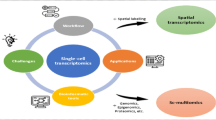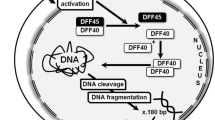Abstract
In Saccharomyces cerevisiae, a typical apoptotic phenotype is induced by some stress factors such as sugars, acetic acid, hydrogen peroxide, aspirin and age. Nevertheless, no data have been reported for apoptosis induced by puromycin, a damaging agent known to induce apoptosis in mammalian cells. We treated S. cerevisiae with puromycin to induce apoptosis and evaluated the percentage of dead cells by using Hoechst 33342 staining, transmission electron microscopy (TEM) and Annexin V flow cytometry (FC) analysis. Hoechst 33342 fluorescence images were processed to acquire parameters to use for multiparameter analysis [and perform a principal component analysis, (PCA)]. Cell viability was evaluated by Rhodamine 123 (Rh 123) and Acridine Orange microscope fluorescence staining. The results show puromycin-induced apoptosis in S. cerevisiae, and the PCA analysis indicated that the increasing percentage of apoptotic cells delineated a well-defined graph profile. The results were supported by TEM and FC. This study gives new insights into yeast apoptosis using puromycin as inducer agent, and PCA analysis may complement molecular analysis facilitating further studies to its detection.





Similar content being viewed by others
References
Achilles J, Harms H, Muller S (2006) Analysis of living S. cerevisiae cell states—a three color approach. Cytom A 69:173–177
Albertini MC, Accorsi A, Teodori L, Pierfelici L, Uguccioni F, Rocchi MBL, Burattini S, Citterio B (2006) Use of multiparameter analysis for Vibrio alginolyticus viable but nonculturable state determination. Cytom A 69:260–265
Allen C, Büttner S, Aragon AD, Thomas JA, Meirelles O, Jaetao JE, Benn D, Ruby SW, Veenhuis M, Madeo F, Werner-Washburne M (2006) Isolation of quiescent and nonquiescent cells from yeast stationary-phase cultures. J Cell Biol 174:89–100
Ameisen JC (2002) On the origin, evolution, and nature of programmed cell death: a timeline of four billion years. Cell Death Differ 9:367–393
Balzan R, Sapienza K, Galea DR, Vassallo N, Frey H, Bannister VH (2004) Aspirin commits yeast cells to apoptosis depending on carbon source. Microbiology 150:109–115
Battistelli M, Borzì RM, Olivotto E, Vitellozzi R, Burattini S, Facchini A, Falcieri E (2005) Cell and matrix morpho-functional analysis in chondrocyte micromasses. Microsc Res Tech 67:286–295
Berlanda J, Kiesslich T, Oberdanner CB, Obermair FJ, Krammer B, Plaetzer K (2006) Characterization of apoptosis induced by photodynamic treatment with hypericin in a431 human epidermoid carcinoma cells. J Environ Pathol Toxicol Oncol 25:173–188
Canonico B, Zamai L, Burattini S, Granger V, Mannello F, Gobbi P, Felici C, Falcieri E, Reilly JT, Barnett D, Papa S (2004) Evaluation of leukocyte stabilisation in TransFix®-treated blood samples by flow cytometry and transmission electron microscopy. J Immunol Methods 295:67–78
Carmona-Gutierrez D, Kroemer G, Madeo F (2012) When death was young: an ancestral apoptotic network in bacteria. Mol Cell 46:552–554
Carmona-Gutierrez D, Eisenberg T, Buttner S, Meisinger C, Kroemer G, Madeo F (2010) Apoptosis in yeast: triggers, pathways, subroutines. Cell Death Differ 17:763–773
Cary GA, Yoon SH, Torres CG, Wang K, Hays M, Ludlow C, Goodlett DR, Dudley AM (2014) Identification and characterization of a drug-sensitive strain enables puromycin-based translational assays in Saccharomyces cerevisiae. Yeast 31(5):167–178
Colussi C, Albertini MC, Coppola S, Rovidati S, Galli F, Ghibelli L (2000) H2O2-induced block of glycolysis as an active ADP ribosylation reaction protecting cells from apoptosis. FASEB J 14(14):2266–2276
Del Carratore R, Della Croce C, Simili M, Taccini E, Scavezzo M, Sbrana S (2002) Cell Cycle and morphological alterations as indicative of apoptosis promoted by UV irradiation in S. cerevisiae. Mutat Res 513:183–191
Domínguez F, Cejudo FJ (2012) A comparison between nuclear dismantling during plant and animal programmed cell death. Plant Sci 197:114–121
Engelberg-Kulka H, Sat B, Reches M, Amitai S, Hazan R (2004) Bacterial programmed cell death systems as targets for antibiotics. Trend Microbiol 12:66–71
Falcieri E, Gobbi P, Cataldi A, Zamai L, Faenza I, Vitale M (1994a) Nuclear pores in the apoptotic cell. Histochem J 26:754–763
Falcieri E, Zamai L, Santi S, Cinti C, Gobbi P, Bosco D, Castaldi A, Betts C, Vitale M (1994b) The behaviour of nuclear domains in the corse of apoptosis. Histochemistry 102:221–231
Ferreira P, Cardoso T, Ferreira F, Fernandes-Ferreira M, Piper P, Sousa MJ (2014) Mentha piperita essential oil induces apoptosis in yeast associated with both cytosolic and mitochondrial ROS-mediated damage. FEMS Yeast Res. doi:10.1111/1567-1364.12189
Ghibelli L, Mengoni F, Lichtner M, Coppola S, De Nicola M, Bergamaschi A, Mastroianni C, Vullo V (2003) Anti-apoptotic effect of HIV protease inhibitors via direct inhibition of calpain. Biochem Pharmacol 66:1505–1512
Granot D, Levine A, Dor-Hefetz E (2003) Sugar-induced apoptosis in yeast cells. FEMS Yeast Res 4:7–13
Hara-Nishimura I, Hatsugai N, Nakaune S, Kuroyanagi M, Nishimura M (2005) Vacuolar processing enzyme: an executor of plant cell death. Curr Opin Plant Biol 8:404–408
Herker E, Jungwirth H, Lehmann KA, Maldener C, Frohlich KU, Wissing S, Buttner S, Fehr M, Sigrist S, Madeo F (2004) Chronological aging leads to apoptosis in yeast. J Cell Biol 164:501–507
Jacobson MD, Weil M, Raff MC (1997) Programmed cell death in animal development. Cell 88:347–354
Laun P, Ramachandran L, Jarolim S, Herker E, Liang P, Wang J, Weinberger M, Burhans DT, Suter B, Madeo F, Burhans WC, Breitenbach M (2005) A comparison of the aging and apoptotic transcriptome of Saccharomyces cerevisiae. FEMS Yeast Res 5:1261–1272
Li B, Gao MH, Zhang XC, Chu XM (2006) Molecular immune mechanism of C-phycocyanin from Spirulina platensis induces apoptosis in HeLa cells in vitro. Biotechnol Appl Biochem 43:155–164
Luchetti F, Canonico B, Curci R, Battistelli M, Papa S, Mannello F, Tarzia G, Falcieri E (2006) Melatonin prevents apoptosis induced by UV-B treatment in U937 cell line. J Pin Res 40:158–167
Ludovico P, Sousa MJ, Silva MT, Leao C, Corte-Real M (2001) Saccharomyces cerevisiae commits to a programmed cell death process in response to acetic acid. Microbiology 147:2409–2415
Ludovico P, Rodrigues F, Almeida A, Silva MT, Barrientos A, Corte-Real M (2002) Cytocrome c release and mitochondria involvement in programmed cell death induced by acetic acid in Saccharomyces cerevisiae. Mol Biol Cell 13:2598–2606
Madeo F, Frohlich E, Frohlich KU (1997) A yeast mutant showing diagnostic markers of early and late apoptosis. J Cell Biol 139:729–734
Madeo F, Frohlich E, Ligr M, Grey M, Sigrist SJ, Wolf DH, Frohlich KU (1999) Oxigen stress: a regulator of apoptosis in yeast. J Cell Biol 145:757–767
Madeo F, Herker E, Maldener C, Wissing S, Lachelt S, Herlan M, Fehr M, Lauber K, Sigrist SJ, Wesselborg S, Frolich KU (2002) A caspase-related protease regulates apoptosis in yeast. Mol Cell 9:911–917
Matsuyama S, Nouraini S, Reed JC (1999) Yeast as a tool for apoptosis research. Curr Opin Microbiol 2:618–623
Mazzoni C, Falcone C (2008) Caspase-dependent apoptosis in yeast. Biochim Biophys Acta 1783:1320–1327
Melcher U (1971) Metabolism of puromycin by yeast cells. Biochim Biophys Acta 246:216–224
Nosseri C, Coppola S, Ghibelli L (1994) Possible involvement of poly-ADP-ribosyl transferase in triggering stress-induced apoptosis on U937 cells. Exp Cell Res 212:367–373
Schindler D, Davies J (1974) Inhibitors of macromolecular synthesis in yeast. Methods Cell Biol 12:17–38
Sharon A, Finkelstein A, Shlezinger N, Hatam I (2009) Fungal apoptosis: function, genes and gene function. FEMS Microbiol Rev 33:833–854
Sheffield LG, Miskiewicz HB, Tannenbaum LB, Mirra SS (2006) Nuclear pore complex proteins in Alzheimer disease. J Neuropathol Exp Neurol 65:45–54
Skulachev VP (2001) The programmed death phenomena, aging, and the Samurai law of biology. Exp Gerontol 36:995–1024
Winderickx J, Delay C, De Vos A, Klinger H, Pellens K, Vanhelmont T, Van Leuven F, Zabrocki P (2008) Protein folding diseases and neurodegeneration: lessons learned from yeast. Biochim Biophys Acta 1783:1381–1395
Wloch-Salamon DM, Bem AE (2013) Types of cell death and methods of their detection in yeast Saccharomyces cerevisiae. J Appl Microbiol 114:287–298
Wyllie AH, Kerr JFR, Currie AR (1980) Cell death: the significance of apoptosis. Int Rev Cytol 68:251–306
Conflict of interest
The authors declare no conflicts of interest.
Author information
Authors and Affiliations
Corresponding author
Additional information
Communicated by Olaf Kniemeyer.
Rights and permissions
About this article
Cite this article
Citterio, B., Albertini, M.C., Ghibelli, L. et al. Multiparameter analysis of apoptosis in puromycin-treated Saccharomyces cerevisiae . Arch Microbiol 197, 773–780 (2015). https://doi.org/10.1007/s00203-015-1110-7
Received:
Revised:
Accepted:
Published:
Issue Date:
DOI: https://doi.org/10.1007/s00203-015-1110-7




